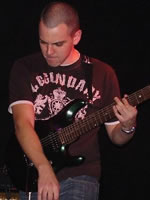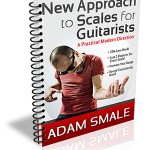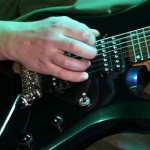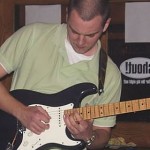There have been many lessons and study pieces written for lead guitar, and they ‘re normally based around the technical aspects of lead playing such as a sweep picking/legato/tapping etc. They are very effective as they take all the variables of a technique and put them into one long piece. This not only saves you practice time, but also gives you an idea of how to link ideas together in a musical way, they are also very good for building up your playing stamina. However, I have not seen any devoted to rhythm playing which is just as vital part of your playing if not more so than lead.

Lewis Turner
I have therefore written a study piece in a metal style. As I’m sure you are aware there are many different aspects and sub genres of Metal, this piece is based on the modern and technical sound of Metal that you may well associate with bands such as Lamb of God.
This piece is long, yet technically challenging in places, changing through various riffs and tempos. The main goal for this piece should be clarity and accuracy, making sure you lock tightly in with the drums. The bass drum is playing the rhythm of all the riffs so you need to make sure that you match up exactly.
Aim for a distorted sound but not too much gain as this will take away the clarity of the notes and ruin your tone. You may find that you can play this piece quite easily, but you should concentrate on ‘HOW’ you play it. This style requires lots of energy in the playing, don’t just tickle the strings, really try to dig in to generate a big sound and great tone, but also add in subtle dynamics.
I’ve not written any dynamic, picking or palm muting markings in on this piece, as you should be the one to experiment and decide what sounds best. However, as a general rule for this type of playing aim for some kind of palm muting most of the time to stop any open strings ringing through, but experiment with the amount of muting for different sounds. Picking everything will give a more percussive sound throughout, but again experiment your own way, maybe try putting in some legato in places to give your picking hand a rest and change the dynamics.
I have broken the TAB down into riffs, there are six different riffs in total, so grab your most metal guitar, stick it in drop D tuning and let’s have a look at each of them.
| Resources for the Metal Riff Exercise – © Lewis Turner | |
|---|---|
| Metal Riff Tab 1 – Riff #1 & #2 (58KB pdf) | |
| Metal Riff Tab 2 – Riff #2 continued (56KB pdf) | |
| Metal Riff Tab 3 – Riff #2 continued & #3 (44KB pdf) | |
| Metal Riff Tab 4 – Riff #3 continued & #4 (62KB pdf) | |
| Metal Riff Tab 5 – Riff #5 (67KB pdf) | |
| Metal Riff Tab 6 – Riff #6 (59KB pdf) | |
| Metal Riff Tab 7 – Final Piece (53KB pdf) | |
| Metal Riff – Complete Track (4.7MB MP3) | |
|
Audio clip: Adobe Flash Player (version 9 or above) is required to play this audio clip. Download the latest version here. You also need to have JavaScript enabled in your browser. |
|
| Metal Riff – Backing Track (4.7MB MP3) | |
|
Audio clip: Adobe Flash Player (version 9 or above) is required to play this audio clip. Download the latest version here. You also need to have JavaScript enabled in your browser. |
|
| Metal Riff – Drums (4.9MB MP3) | |
|
Audio clip: Adobe Flash Player (version 9 or above) is required to play this audio clip. Download the latest version here. You also need to have JavaScript enabled in your browser. |
|
This is the opening riff of the study piece and starts at a fairly reasonable 120 bpm. The bulk of the riff is played using 8th note triplets, 3 notes per beat (count, one and a two and a three and a four and a). It is all based around the Phrygian mode which is very common in metal, as the flat 2 gives quite a dark sound. Look out for the groups of 6 towards the end of the riff, try alternate picking them to get a machine gun like sound.
This is the quirky riff in the piece, again the majority of it is 8th note triplets, with some 16th note triplets thrown in. This uses the flat 5 interval a lot and could be viewed as coming from the Locrian mode as it also contains the flat 2. There are chromatic runs in there that make it quite tricky to pick through. The riff ends with a very quick 16th note triplet run (6 notes per beat) at 120 bpm. This may take you some time to master. Try to isolate it and work on it to a much slower metronome pulse and gradually increase it, this applies to any parts of the piece that you find hard.
Is a real picking hand workout. The tempo has now raced up to 200 bpm, and you are now playing a common broken up 16th pattern that has been used in many metal tunes. The only relief comes in the shape of some good old power chords, including a dimished one that are played as just quarter notes. Remember this section should be played with ultimate energy and accuracy, dig in people!
We are still at 200 bpm but you are now playing 8th notes (two notes per beat) and in a half time feel. Half time is very common in metal. Rather than the snare hitting on beats 2 + 4, it is now just hit on beat 3 and it gives the feel of everything slowing down but the tempo has stayed the same. It is very effective and gives a real heavy sound. The riff is very similar to riff #1 broken up with 16th notes and the power chords used in riff #3.
The tempo has changed this time to a more reasonable 176 bpm. This riff uses a chromatic idea broken up with some low end power chords. This one is very hard to get sounding tight as there are silent breaks and any un-muted strings will ring through and kill the whole feel of it. There is also a section containing a couple of big chords that ring just to break things up, pay careful attention to what beat they change on as one changes on beat 4. The snare drum pattern is also quite confusing on this section, again try to lock into the bass drum.
The final riff of the piece and the heaviest. It is technically the easiest to play, but as mentioned before without careful attention to the muting it may well end up sounding messy. Look out at bar 63 where there is rhythmic displacement. It is the same rhythm as before but it now starts on the last 8th note of the bar so the whole riff has basically been pushed by an 8th note. This is a real neat trick you can use to spice up simple riffs. At the end of bar 69 it pushes back again to the same feel as the start of the riff.
The piece ends on riff #4 but at this new tempo.
Attached, you will find three tracks. The whole track, a backing track with a second guitar panned to one side quietly in the background to add a little depth. There’s also a track with just the drums so you can hear the bass drum and really work on locking into it.
That’s the whole piece! Take your time with it and work on one section at a time slowly to a metronome and then to the track. I think you will find it just as much fun as doing a lead study piece and you may be surprised at how tired your picking hand gets playing this. It will improve your rhythm and riff playing as well as timing and accuracy. Most importantly remember to play with power, feel and good tone.
All content © Lewis Turner – For more information about Lewis Turner, please visit:






















Lewis Turner is a highly accomplished guitarist, with years of performing, recording, session and teaching experience. Lewis performs all over the UK and abroad with various bands as well as Theatre, TV and Radio work

Leave a Reply